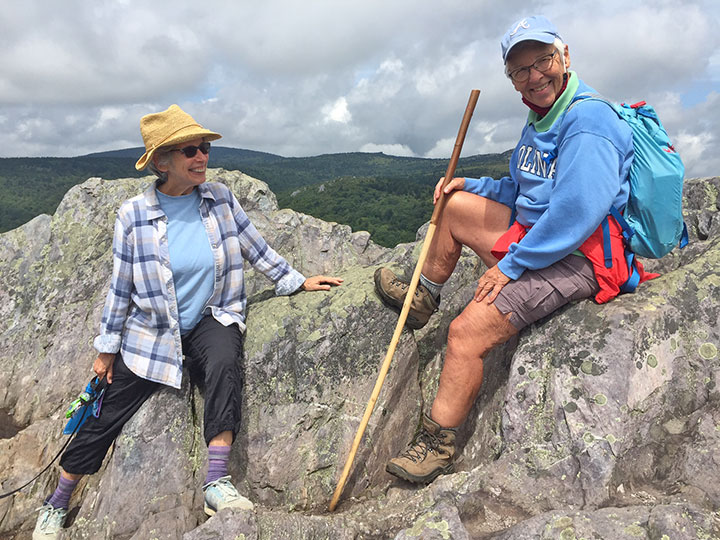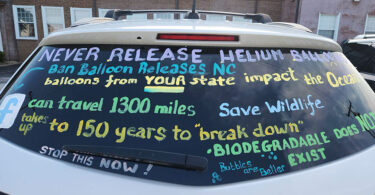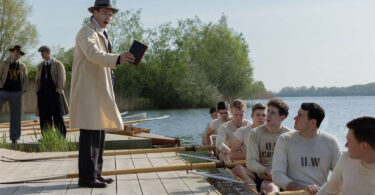Second Of Two Parts
Ginger Travis
In 2020 as the pandemic got unimaginably worse, camping saved us from losing our minds. We did eight trips in seven months, May through November. The first two trips were described in Part 1.
But our big lesson from 2020 still applies: reservations are required. Make them early! Everyone in America seems to have gone outside. Now it’s 2021 and we’re headed out again. What’s changed is that we’ve been vaccinated.
This time around we will not fear using the often cramped, poorly ventilated campground bathrooms, which seemed way too risky in 2020.
You’ll see last year’s alternative below. But this year we’ll still be cautious near other people, which means wearing our masks. Whether COVID recedes or roars back, we know that being outside in nature is the safe, sane spot for us. And we highly recommend all the places where we camped.
Roan Mountain State Park, TN, July 13-17. The attraction here is a beautiful campground at about 3,000 feet, surrounded by rhododendron, with close proximity to the highest peak in TN, the 6,286-foot Roan Mountain. Starting at Carvers Gap on the NC-TN state line, for several miles a hiking trail crosses incredibly beautiful grassy balds at 5,500 feet and above. It’s the top of the world, and views are sublime.
Hordes of hikers came out to see it in 2020, even on weekdays. Last July most hikers did not wear masks, though many politely stepped off trail to give those passing some distance. Roan High Bluff, on the opposite side of Carvers Gap, was empty and beautiful when we were there. We quickly learned that choosing a less-used trail is a good strategy.
Lake Powhatan Recreation Area and Campground, near Asheville, Aug 10-13. This campground is just off the Blue Ridge Parkway behind the NC Arboretum. We took my partner Cathy’s great-nephew Bryce, age 10, and his dad Wayne for their second-ever camping experience, the first being here in 2018. The swim beach at the lake was a big hit. Bryce in 2018 had learned to make a campfire. In 2020 he was given his own hiking stick (cut and peeled at home by Aunt Ginger) to decorate, and he performed his first assigned camp chore: fetching water to the site. Bryce used his new stick when we hiked at Graveyard Fields on the Blue Ridge Parkway. It was incredibly rewarding for Aunt Cathy and Aunt Ginger to see this boy love camping.
When he went back to school that month and each student had to bring an object to introduce him or herself, Bryce took his hiking stick and his baseball cap and announced, “I’m a camper and a baseball player.” Yes!!!!! Campers headed for Powhatan need to know there are bears in the campground. Scrupulous storage of food, drink and toiletries in a closed car is a must—and is enforced by the park. Powhatan was the first campground where we used our brand-new popup utility tent with a portable toilet inside. We were just too weirded out by poorly ventilated campground bathhouses being used by maskless people.
Grayson Highlands State Park, VA, Aug 23-26. This park, just over the state line from Ashe County, NC, is one of our all-time favorite places. It’s high and cool and suggestive of Wyoming with its rocky, grassy slopes dotted with red spruce trees. The dominant shrub is blueberry, but we were two weeks too late to pick. The campground is at about 4,400 feet. Trails lead up to bare rock pinnacles above 5,000. The highest peak in VA, Mount Rogers (5,729 feet) is a 10-mile roundtrip hike from Massie Gap in the park. Wild ponies in the high country are a big draw.
We saw a lot of hikers, but they had room to spread out, so the trails seemed less congested than on the balds at Roan Mountain. We also found some less-used trails. More people were wearing masks by this point in the summer, and we were glad.
Stone Mountain State Park, NC, Sep 22-24. An iconic granite monadnock, elevation 2,305 feet, gives this park its name. Although a mountain, it sits just a few miles east of the Blue Ridge Escarpment and a thousand feet lower; it is actually in the piedmont in Wilkes and Allegheny counties.
Our trip here was cut short by bad weather moving in. We had only one full day to hike, but it was great, up over Wolf Rock and Cedar Rock – granite domes – to look back across a stream valley at the alpha-rock itself, Stone Mountain. I can’t think of too many landforms as strange as the many acres of bare granite resembling a cold barren moonscape. Lichens colonizing gray rock, slightly acid rainfall slowly pitting the rock over millennia, stunted cedar trees growing out of an isolated crack or an inches-deep depression – it’s all pretty weird and compelling.
Stone Mountain’s tent sites were spacious and spread out. We had tons of privacy. But the separate area for trailers and RVs looked like a parking lot, crowded and bare. (This was the case at Roan Mtn State Park too.)
Great Dismal Swamp National Wildlife Refuge, VA, Oct 5-7. This is easy kayak- and canoe-in camping—3.5 miles one way on very protected canals. The Great Dismal stretches over thousands of acres in eastern VA and NC. There’s a state park on the NC side of the line but no camping. In VA, there’s a boat ramp off Hwy 17 at Balahack Rd. with access to the Dismal Swamp Canal. From there you can paddle up the Feeder Ditch to a high bit of ground where there’s a small dam to regulate outflow from Lake Drummond in the heart of the swamp.
Camping on that high ground is allowed. (Thank you, U.S. Fish and Wildlife Service.) It has picnic tables and a couple of screen houses, and even an alarmingly rusty flush toilet. But there are no designated campsites, no fees and no reservations. Pretty wonderful! We arrived on Monday afternoon as weekenders were leaving and had the place all to ourselves. We put up our tent and then pulled our canoe over from the low side to the high side of the dam and relaunched to paddle out to Lake Drummond.
The lake is roughly oval and up to five miles across (wide-open water, caution required). It can be magical when the water is mirror-calm. The old hollow cypresses are enchanting, and gardens sprout from their swollen bases: swamp rose and sedges growing out of cracks in the bark that have accumulated tiny pockets of soil. Not too many people make this trip, so it’s all the more special.
Pettigrew State Park, NC, Nov 16-21. Last trip, and it was cold! Nights in the 30s. We burned campfires night and morning. Pettigrew is on the shores of Lake Phelps a short way off Hwy 64. It’s only an hour from the Outer Banks. Pungo Lake is a few miles to the south. All of these locations attract wintering waterfowl. We couldn’t find Snow Geese, but huge white Tundra Swans were everywhere. They flew over our campsite every morning at coffee time. We’d hear them coming as they gabbled nonstop; then they’d be overhead aglow in the morning’s first sunlight. Pettigrew has only 13 campsites and seems to have become more popular despite its isolated location. It’s a great base camp for paddlers and nature lovers—well worth repeat visits.
And with that trip, our 2020 pandemic camping was over. Great times. And more to come in 2021, as we dodge the virus. Hope you do the same!









